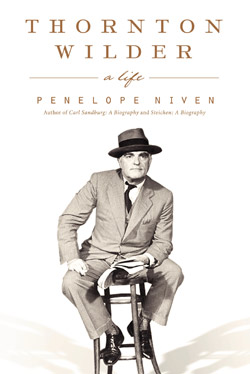 “The years at Chicago were among the happiest in my life.” That’s Thornton Wilder toward the end of his long, peripatetic life—a quote that appears toward the end of Penelope Niven’s long, perspicacious Thornton Wilder: A Life, published this month by Harper ($39.99). In his day (1897–1975), Wilder was a multigenre literary giant, with a Pulitzer for his novel The Bridge of San Luis Rey, and two more for his plays Our Town and The Skin of Our Teeth. Today, he’s only hazily remembered, as probably is the intimate link between him and our city.
“The years at Chicago were among the happiest in my life.” That’s Thornton Wilder toward the end of his long, peripatetic life—a quote that appears toward the end of Penelope Niven’s long, perspicacious Thornton Wilder: A Life, published this month by Harper ($39.99). In his day (1897–1975), Wilder was a multigenre literary giant, with a Pulitzer for his novel The Bridge of San Luis Rey, and two more for his plays Our Town and The Skin of Our Teeth. Today, he’s only hazily remembered, as probably is the intimate link between him and our city.
Wilder came here in 1930, invited by his old friend Robert Maynard Hutchins—the education wunderkind who reinvented the U. of C. in his own image—to lecture in Hyde Park on Aeschylus, Cervantes, and other topics of his own choosing. “The teaching work is really necessary to me,” said Wilder. “I write very little and slowly and I need a congenial daily routine to occupy me while the dim notions for books shape themselves.” At the beginning of each class, Wilder explained to a friend, he made students write “a 6-minute paper . . . to prove that they read the long assignment for homework. It’s absurd, but is very American and is exactly what I want.”
“Between lecture commitments and teaching obligations,” Niven continues, “he made trips to Hollywood, Hawaii. Europe, and the West Indies.” He also chipped in to a secret trustees’ fund that helped out struggling, Depression-era students, who, Wilder claimed, were “fainting in the corridors for lack of food and doing unheard of feats to get an education.”
Shy as a young man, Wilder, a celebrity now who regularly popped up in the Chicago gossip columns, delighted in his role as (in Niven’s words) “the handsome, dapper bachelor with impeccable manners, an engaging wit, and an infectious ebullience for all his erudition.” He reveled in the 1933 Century of Progress world’s fair, one night pulling the poet Edna St. Vincent Millay for a mile along the Lake Michigan shoreline in a rickshaw. “The Fair is not serious, but it’s fun,” he wrote an old friend, the actress Ruth Gordon. “Artistically it’s one big lapse of taste, but on such a big scale that it becomes somehow important. I love it.”
Even more, he was enthralled with Chicago. “[It] rapidly became his hometown,” explains Niven. “All in all, there was probably no city he loved more . . . . He made Chicago his city.”
Other stars crossed his orbit. In the year of the fair, he wrote to Alexander Woollcott (he of the Algonquin Round Table) about his new discovery, a “rather pudgy-faced youngster with a wing of brown hair falling into his eyes . . . . The name is Orson Welles and he is going far.” In November 1934, his good friend Bobsy Goldspeed, the city’s cultural polestar, introduced him to Gertrude Stein, in town on the tide of her own, unexpected expatriate celebrity. On her return a few months later, Wilder surrendered his South Side apartment to Stein as she delivered her alluringly opaque lectures at the University of Chicago. It was, as Niven rightly acknowledges, a pivotal friendship for the two of them, one that would endure until Stein’s death in July 1946.
While here, Wilder struggled with his sexuality. A gregarious dinner guest and a fine dancer, he could have passed as a ladies man. He seems even to have fooled himself. He funded a post-college trip to Europe for a grave, handsome philosophy major named Robert Davis, meeting him innocently along the way for an extended motor trip to the rural French summer home Stein shared with her “companion-lover-amanuensis” Alice B. Toklas.
Things took a different turn with the English professor Samuel Steward, who taught at Loyola and DePaul and later gained notoriety as the tattoo artist Phil Sparrow and the erotic gay novelist Phil Andros. The two men met in Zurich in September 1937, where, it seems, they had at least one clumsy sexual encounter. According to Steward, the affair continued back in Chicago. “Thornton always went about sex as though it was something going on behind his back and he didn’t know anything about it,” Steward recalled years later.
Wilder stopped teaching at the U. of C. in 1937. He returned occasionally to the city and remained close friends with Hutchins, who invited him to lecture in July 1949 at the Goethe festival in the old Colorado silver town of Aspen, then being transformed into a mountain resort—“a sort of Chautauqua of the West,” as Niven aptly describes it—by the Chicagoan Walter Paepcke. Wilder dedicated his last novel, Theophilus North, to Hutchins, who reciprocated by eulogizing his old friend at his January 1976 memorial service.
As a young man, Wilder confessed, “I weep myself ill over biography.” An intensely private man, he’d likely have cried a river over Niven’s extraordinary rendering of his life. As for me, the mark of a good literary biography is that it compels you to go back and explore a writer’s work. In this instance, I picked up Wilder’s Bridge of San Luis Rey, which I’d first read—and found tedious—when I was 12 or 13. What a revelation! It turns out that good books, like youth itself, are often wasted on the young.


